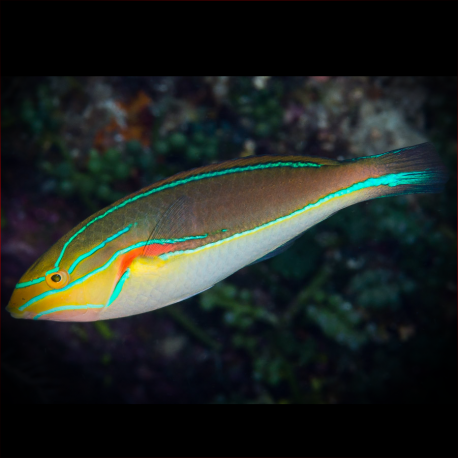More info
Datasheet
| Minimum Tank Size | 1000 litres / 264.17 US gallons |
| Maximum Size | 15.0cm / 5.91inches |
| Reef Compatible | Always reef safe |
| Temperament | Mostly peaceful but might be aggressive towards similar species |
| Temperature | 22.2°C / 71.96°F - 25.6°C / 78.08°F |
| Specific Gravity | 1.020-1.025 |
| Carbonate Hardness | 8-12 |
| pH | 8.1-8.4 |
General Description
The Stethojulis bandanensis, commonly known as the Red shoulder wrasse or Orange-axil wrasse, is a stunning fish species within the Labridae family. These wrasses display vibrant colors when fully matured, with a matte appearance in their youth.
Aquarium Suitability
Aquarists need to be aware of the demanding nature of the Red shoulder wrasse. These fish require constant feeding due to their high activity levels. This species is best suited for experienced aquarists who can provide a well-established tank with ample space for swimming.
Care and Hardiness
The Red shoulder wrasse has an average hardiness level and is sensitive during transportation and acclimatization into the aquarium. They are docile and require good hiding spots within the aquarium to feel secure.
Reef Suitability
Considered reef safe, the Red shoulder wrasse is a suitable addition to reef aquariums.
Aquarium Setup
For keeping a Red shoulder wrasse, a tank of a minimum size of 1000 liters is recommended. A deep sandy substrate of at least 5 cm is needed to allow the fish to bury itself when threatened or in need of rest. Additionally, the tank should have plenty of hiding places, such as live rocks.
Behaviour
These wrasses are mostly peaceful but may show aggression towards similar species. When threatened or tired, they exhibit a behavior of burying themselves in the sand.
Feeding and Diet
Feeding a varied diet is crucial for the Red shoulder wrasse's well-being. They consume frozen foods like Mysis, Artemia, and cyclops, and can pose a threat to small invertebrates.
Dimorphism
The Red shoulder wrasse is hermaphroditic, with the ability to change from female to male. These fish can coexist as a pair if introduced simultaneously.
Habitat and Distribution
Native to the East Indian Ocean, Australia, Indonesia, and the Central/West Pacific, the Red shoulder wrasse inhabits a wide range including offshore islands in the eastern Pacific. They require a habitat with a well-established population of microorganisms like copepods and amphipods for sustained feeding.

